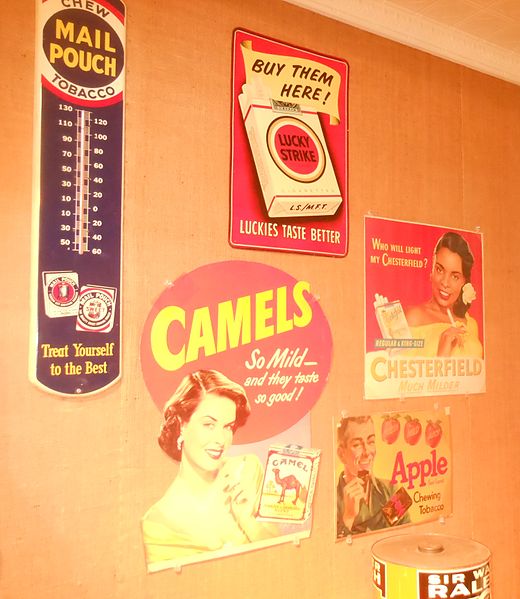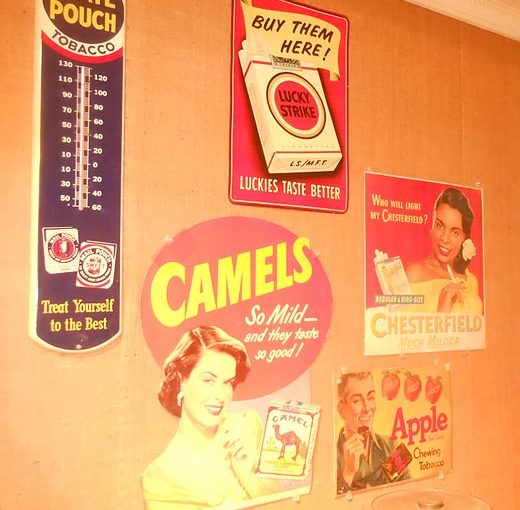
Old tobacco advertisements. Unbelievable people would fall for this.
The world revolves around the use and sales of tobacco. Farmers look to make profits off the poor souls who fall victim to tobacco addiction. Fortunately for them, that includes a large percentage of the population.
When I think of the backbone of America, three things come to my mind: alcohol, McDonald’s and cigarettes. Cigarettes are iconic in America. You see them in movies and TV shows all the time. There’s nothing like sitting down in your warm house on a chilly Christmas Eve night watching a Christmas movie on the Hallmark Channel about to spark up a cigarette in 1984. To me, that’s about as iconic as it can get. Despite this, it’s not the ’80s anymore. Cigarettes aren’t cool, and they’re arguably one of the worst addictions a human can have. It’s just not worth it to do this to your body.
All cigarette advertisements will be banned eventually; it’s just a matter of time.
While smoking is still an issue, it can’t compare to the issue it was in the early to mid-1900s. Cigarettes were handed out to soldiers in both world wars for free. Nobody is going to deny a free cigarette. Of course, the situation was way different at the time, and you could argue cigarettes were helpful for the soldiers given the stress they were dealing with. Cigarettes used to be legal to smoke almost everywhere. It’s only been somewhat recently that there have been restrictions on where cigarettes can be smoked.
Cigarettes used to be legal to smoke in all restaurants and bars. Now, there’s only a select amount of states that allow smoking at bars and restaurants. It’s only a matter of time before they’re illegal in all restaurants and bars. A majority of states allow smoking in casinos, which I think will take longer to ban than smoking in restaurants or bars. The sooner these bans take place, the more we will see a decline in smoking among teens.
Advertisements for tobacco were banned in 1971 for TV and radio, and 1986 for the ban of smokeless tobacco products. In 1998, the Master Settlement Agreement imposed many restrictions on major U.S. tobacco companies. This included bans on transit and billboard advertisements, paid brand product placement, cartoons, tobacco brand sponsorships of sporting events and concerts, as well as advertising and marketing practices that targeted individuals under 18. Since these changes, tobacco use among teens has significantly dropped.
According to the U.S. Department of Health and Human Services, the percent of seniors in high school who reported to smoking daily dropped from 28.8 percent in 1976 to 5.5 percent in 2015. The number continues to drop due to the absence of advertisements, which is why all advertisements should come to a close. There are still signs with deals on cigarette packs on the outer walls of gas stations. If those were eliminated, I feel like the number of teens that smoke would go down drastically. It would also reduce the interest of minors wanting to purchase cigarettes. If they don’t see a deal on cigarette packs outside of a gas station, they will be less obligated to try cigarettes. If they’re less obligated to buy them, they will have a lesser chance of smoking them and possibly become addicted (see how that works).
Cigarettes aren’t cool, they’re arguably one of the worst addictions a human can have.
While smoking is still an issue, the emergence of new ways to get “nic buzzed” is contributing to the decline. When I say new ways I’m talking about Juuls, E-Cigs, Suorin Airs, Suorin Drops, etc. While these may be a “safer” alternative to cigarettes, I wouldn’t call them safe. They don’t contain the chemicals and tar that are present in cigarettes, but the nicotine content in some of these devices is greater than cigarettes. From what I’ve heard, one Juul pod has the equivalent nicotine level as a whole pack of cigarettes. That being said, the effects that nicotine has on the brain are he same if not worse with these new devices. While they won’t give you yellow teeth, smelly breath or black lungs, they still contain high amounts of nicotine. It’s been only recently that these devices have been introduced. Because of this, there’s no real proof that they affect your body negatively later in life. I like them in the sense they help reduce cigarette smoking among teens. The only issue with these is that kids may resort to them instead of cigarettes. While that may be safer, you’re still putting a large dose of nicotine in your body. Please, use these devices safely and wisely.
All cigarette advertisements will be banned eventually; it’s just a matter of time. The smoking rates among teens will continue to decline as the years go on as long as alternatives are available. To the extent, teens take these alternatives is yet to be determined, but right now it doesn’t look great. However, it’s still better than becoming addicted to cigarettes. As long as we continue to get rid of smoking indoors and reduce and eventually get rid of advertisements, cigarette smokers will reduce in the future years.
